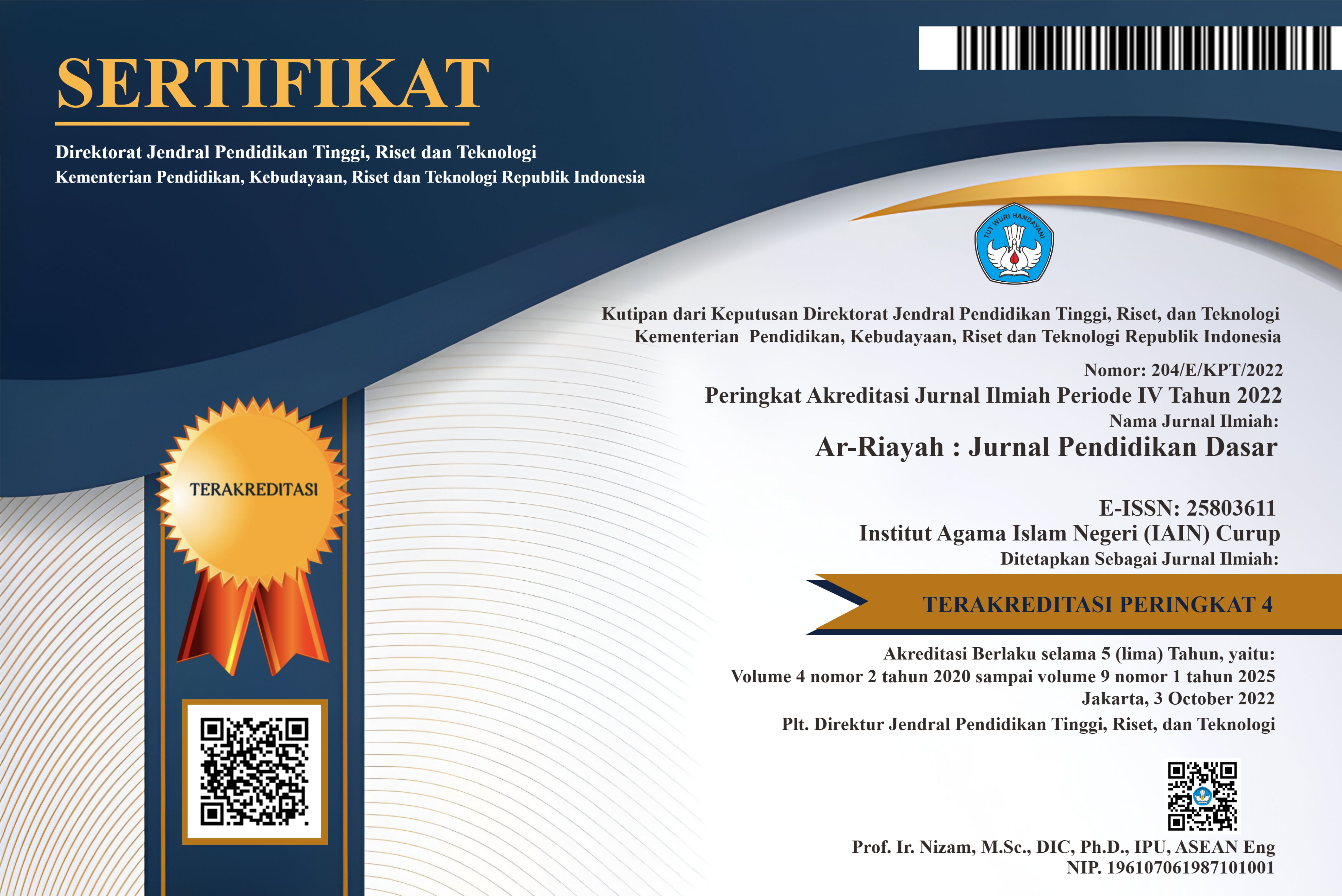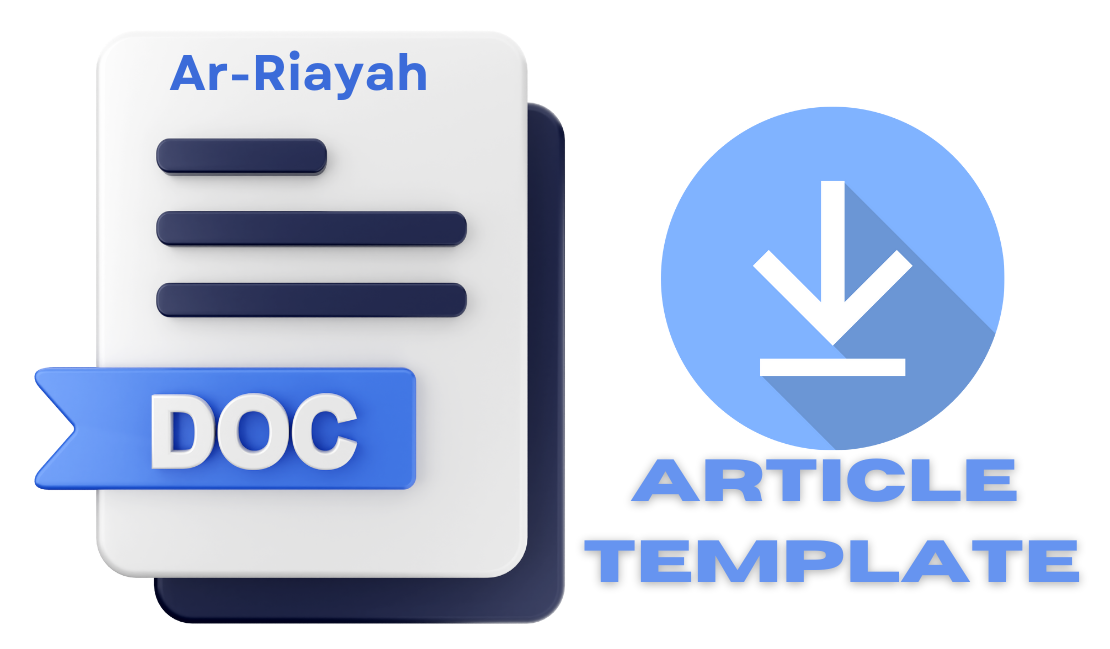Analisis Respon Siswa MI Terhadap Model SiklusBelajar Berbasis Positive Learning Environment (Sibelpolen) Sebagai Upaya Optimalisasi Literasi Sains
DOI:
https://doi.org/10.29240/jpd.v6i1.4351Keywords:
Positive learning environment, Learning Cycle, Scientific LiteracyAbstract
Downloads
References
Åström, J, and L H Thorell. “Graphometric Variables of One’s Signature: II. Correlations with Measures of Perception, Cognitive Function, and Personality.†Perceptual and Motor Skills 107, no. 1 (August 1, 2008): 197–221. https://doi.org/10.2466/pms.107.1.197-221.
Bohach, By Barbara M, and Birgitta Meade. “Fifth Graders Take an Interdisciplinary Field Trip to a Farm and Learn Science and Local History in the Process.,†n.d., 34–41.
Brok, P den, D Fisher, and R Scott. “The Importance of Teacher Interpersonal Behaviour for Student Attitudes in Brunei Primary Science Classes.†… Journal of Science Education, 2005. https://doi.org/10.1080/09500690500038488.
Bybee, R W, J a Taylor, a Gardner, P V Scotter, J C Powell, a Westbrook, and N Landes. “The BSCS 5E Instructional Model: Origins, Effectiveness, and Applications.†Bscs, 2006.
Calp, Şükran. “Peaceful and Happy Schools : How to Build Positive Learning Environments.†International Electronic Journal of Elementary Education 12, no. 4 (2020): 311–20. https://doi.org/10.26822/iejee.2020459460.
Fierman, William. “Learning to Become Turkmen: Literacy, Language and Power, 1914–2014.†Central Asian Survey. Informa UK Limited, 2018. https://doi.org/10.1080/02634937.2018.1556528.
Jarrett, Olga. “‘Inventive’ Learning Stations;Suggestions for Creative, Engaging and Manageable Science Learning Stations.†Science & Children, 2010, 56–59.
Kaneko, J. “Ethics in Education for Sustainable Finance: Challenges Toward Long-Termism in Japan and Europe.†Handbook on Ethics in Finance, 2021. https://doi.org/10.1007/978-3-030-29371-0_13.
Kiener, Michael, Peter Green, and Kelly Ahuna. “Using the Comfortability-in-Learning Scale to Enhance Positive Classroom Learning Environments.†InSight: A Journal of Scholarly Teaching 9 (2014): 36–43. http://search.proquest.com/docview/1651861229?accountid=14744%5Cnhttp://vs4ee7hh3a.search.serialssolutions.com/directLink?&atitle=Using+the+Comfortability-in-Learning+Scale+to+Enhance+Positive+Classroom+Learning+Environments&author=Kiener,+Michael;Green,+.
Krantz, Patrick D. “Inquiry, Slime and The National Standards.†Science Activities Vol.41 No., no. 1989 (1996): 22–26.
Liao, Hung-Chang, and Ya-Huei Wang. “Creating A Positive Learning Environment For Students With English Classroom Anxiety 1.†Psychological Reports 116, no. 2 (2015): 631–46. https://doi.org/10.2466/11.PR0.116k21w8.
Mcdonald, Tim. “Positive Learning Framework.†Reclaiming Children and Youth 19 (2010): 16–20. http://reclaimingjournal.com/issues/positive-learning-framework.
Moleong, LJ. Metodologi Penulisan Kualitatif. Metodologi Penulisan. Bandung: Rosda Karya, 2006.
“Non-Consolidated Stocks, by Instrument and by Sector: Finland.†Organisation for Economic Co-Operation and Development (OECD), 2015. https://doi.org/10.1787/na_fbs-2014-table63-en.
Seifer, Marc. The Definitive Book of Handwriting Analysis_ The Complete Guide to Interpreting Personalities, Detecting Forgeries, and Revealing Brain Activity Through the Science of Graphology. USA America: Career Press, 2009. https://books.google.co.id/books?hl=id&lr=&id=KR-ODwAAQBAJ&oi=fnd&pg=PT25&dq=grafologi+for+exploring+emotional+children&ots=hELJG4hvi_&sig=keLyfhven6vu4wisBcPO1l1TT1Q&redir_esc=y#v=onepage&q&f=false.
Selmer, Sarah J, A Rye, Elizabeth Malone, and Danielle Fernandez. “What Should We Grow in Our School Garden to Sell at the Farmers ’ Market ? Initiating Statistical Literacy through Science and Mathematics Integration.†Science Activities, 2014, 17–32. https://doi.org/10.1080/00368121.2013.860418.
Sugiyono. “MetodePenulisan Kuantitatif, Kualitatif Dan R&D. Bandung: PT Alfabet.†Sugiyono. (2017). MetodePenulisan Kuantitatif, Kualitatif Dan R&D. Bandung: PT Alfabet., 2017.
Suharsimi, Arikunto. Metodologi Penulisan. Bumi Aksara, 2013.
Suprapto, N. “What Should Educational Reform in Indonesia Look like?-Learning from the PISA Science Scores of East-Asian Countries and Singapore.†Asia-Pacific Forum On Science Learning & Teaching. ied.edu.hk, 2016. https://www.ied.edu.hk/apfslt/download/v17_issue2_files/suprapto.pdf.
Syamsi, Atikah, Zulela M.S., and Yufiarti Yufiarti. “Improving Students’ Scientific Literacy through the Cycle-Based Learning Model.†TARBIYA: Journal of Education in Muslim Society, 2020. https://doi.org/10.15408/tjems.v7i1.16941.
Syamsi, Atikah, and Zulela Saleh. “Modification of a Learning Cycle Model Based on Positive Learning Environment to Improve Primary School StudentsScientific Literacy†58 (2021): 1056–69. https://doi.org/https://doi.org/10.17762/pae.v58i3.3100.
Syamsi, Atikah, M. S Zulela, and Yufiarti. “Implementation of Learning Cycle Method Based on Positive Learning Environment as an Effort to Increase Science Literacy of Primary School Students†491, no. Ijcah (2020): 410–15. https://doi.org/10.2991/assehr.k.201201.075.
Wilder, Melinda; shuttleworth, phyllis. “Cell Inquiry : A 5E Learning Cycle Lessons.†Science & Children 41, no. 1 (2004): 25–31.
Wilder, Melinda, and Phyllis Shuttleworth. “Cell Inquiry : A 5E Learning Cycle Lesson.†Science Activities 41, no. 1 (2004): 25–31.
Winokur, By Jeff, Karen Worth, and Martha Heller-winokur. “Connecting Science and Literacy Through Talk.†Science & Children, 2009, 46–49.
Downloads
Additional Files
Published
How to Cite
Issue
Section
Citation Check
License
Copyright (c) 2022 Atikah Syamsi

This work is licensed under a Creative Commons Attribution-NonCommercial-ShareAlike 4.0 International License.
Authors who publish with Ar-Riayah: Jurnal Pendidikan Dasar agree to the following terms:
Authors retain copyright and grant the journal right of first publication with the work simultaneously licensed under a Creative Commons Attribution-NonCommercial-ShareAlike 4.0 International License (CC BY-NC-SA 4.0) that allows others to share the work with an acknowledgment of the work's authorship and initial publication in this journal.
Authors are able to enter into separate, additional contractual arrangements for the non-exclusive distribution of the journal's published version of the work (e.g., post it to an institutional repository or publish it in a book), with an acknowledgment of its initial publication in this journal.
- Authors are permitted and encouraged to post their work online (e.g., in institutional repositories or on their website) prior to and during the submission process, as it can lead to productive exchanges, as well as earlier and greater citation of published work (See The Effect of Open Access).










